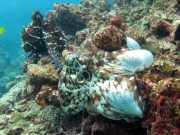Diving with Octopus
Lanta Marine Life | Octopodidae
Octopus are soft bodied, eight limbed molluscs within the group cephalopod, and are sometimes seen during Koh Lanta dive trips.
The eight arms are covered on the inside with rows of suckers which are equipped with chemoreceptors, allowing the octopus to taste what they touch.
As octopus are boneless, they are very flexible and can squeeze through very tight spaces. The only solid structure is their small hard beak made of chitin, which can deliver a nasty bite with venomous saliva when stunning prey. Their beak size will determine what size space they can fit through.
Octopus are masters of camouflage and have specialised skin cells which can allow them to display a variety of colours, patterns and elaborate skin textures. As carnivores, they feed on crustacea, molluscs, fish and other cephalopods.
If under attack from a predator such as a Shark or Moray Eel, an Octopus will release a cloud of black ink. The ink will dull a predator's sense of smell, making the fleeing octopus harder to track. Fast swimmers, they can jet forward by expelling water through their mantles. If all else fails, they can lose an arm to escape a predator's grasp and regrow it later.
Octopus have a short life expectancy of 1-3 years, as males can live for only a few months after mating, and females die shortly after their eggs hatch. The females neglect to eat during the one-month period spent taking care of their unhatched eggs, eventually dying of starvation.
1 species found on this page:
Day Octopus
(Octopus cyanea)
Day octopus (Octopus cyanea) are a cephalopod, and the most common octopus found inhabiting the reefs off Koh Lanta. They are up to 85 cm long and typically a brown/red colour with rows of light spots along their arms. These spots are not always visible depending on the display of the individual.
As their name suggests the Day Octopus feeds during the day, so its need for camouflage then is very important.

Octopus cyanea @ Koh Bida
This species has three hearts: two hearts to pump blood through each of the two gills, while the 3rd heart pumps blood through the body. Their blood contains the copper-rich protein Hemocyanin for transporting oxygen and gives their blood a bluish colour. The octopus draws water into its mantle cavity, where it passes through its gills.
When octopuses reproduce, the male uses a specialised arm, called the Hectocotylus, to transfer packets of sperm into the female's mantle cavity.
In some species, the female octopus can keep the sperm alive inside her for weeks until her eggs are mature for fertilisation. A juvenile octopus grows at a rapid rate, increasing it's weight by 5% each day.
Diving with Octopus around Koh Lanta
Scuba Diving & Snorkel Trips
If you'd love a chance to spot Octopus on one of our daily high season diving trips from Koh Lanta then send us an email to info@diveandrelax.com.
Join our high season speedboat dive trips to some of Thailand's best dive sites and enjoy small groups, short journey times, with a focus on great personal service, safety and fun.
Not yet a certified diver? Learn to Scuba Dive on Koh Lanta with the 3 day SSI Open Water Diver course.
Book online to save 10% on dive trips and scuba courses on Koh Lanta.
Find Out More
Indo-Pacific Marine Life Guides
- Allen, G., Steene, R., Humann, P., DeLoach, N. (2003) Reef Fish Identification, Tropical Pacific. Jacksonville, FL., USA: New World Publications, Inc., ISBN 1-878348-36-1.
- Humann, P., DeLoach, N., (2010) Reef Creature Identification, Tropical Pacific. Jacksonville, FL., USA: New World Publications Inc., ISBN 978-1-878348-44-9
- Debelius, H. (2013) Indian Ocean Reef Guide. Frankfurt, Germany: IKAN - Unterwasserarchiv, ISBN 978-3-939767-52-7.
- Debelius, H. (2004) Nudibranchs and Sea Snails, Indo-Pacific Field Guide. Frankfurt, Germany: IKAN - Unterwasserarchiv, ISBN 3-925919-51-1
- Erhardt, H., Knop, D. (2015) Corals Indo-Pacific Field Guide. Frankfurt, Germany: IKAN - Unterwasserarchiv, ISBN 3-925919-69-4.
- Veron J.E.N., Stafford-Smith M.G., Turak E. and DeVantier L.M. (2016). Corals of the World


